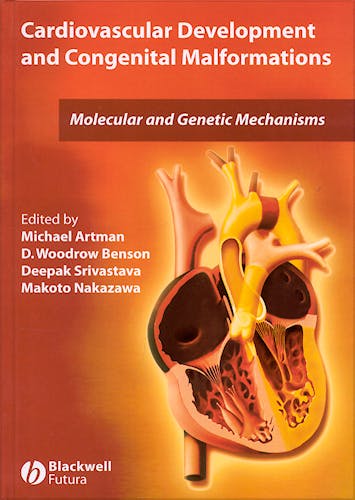

No hay productos en el carrito



Cardiovascular Development and Congenital Malformations
Artman M.
1ª Edición Junio 2005
Inglés
292 pags
2000 gr
18 x 26 x 2 cm
ISBN 9781405131285
Editorial BLACKWELL
This book brings together the leading scientists from around the world who are actively engaged in studies of the etiology, morphogenesis and physiology of congenital cardiovascular diseases. A broad variety of approaches, techniques, experimental models and studies of human genetics combine to make this a truly outstanding and unique treatise on this pressing topic.
Cardiovascular Development and Congenital Malformations is divided into distinct categories, each focusing on a particular aspect of cardiovascular development. Sections are accompanied by editorial overviews which integrate new findings and place the information into a broader context.
Contents
Establishing Left-Right Patterning and Cardiac Looping
1, Microenvironment provides left–right instructions to migrating precardiac mesoderm
2, Calmodulin- inv protein interaction and left-right determination
3, Misexpression of upstream laterality genes on downstream mechanisms of heart looping: A flectin perspective.
4, Pleiotropic effects of Pitx2 isoform c on morphogenesis in the mammalian heart
5, Signal transductions during cardiac myofibrillogenesis and looping
6, Biological role of fibulin-2 in cardiovascular development
Mechanisms of Cardiogenesis and Myocardial Development
7, TBX5 regulates cardiac cell behavior during cardiogenesis
8, Cardiac homeobox protein Csx/Nkx2-5and its associated proteins
9, Regulation of myocardium formation after the initial development of the linear heart tube
10, The Role of the extracellular matrix (ECM) in cardiac development
11, Teratogenic effects of bis-diamine on the developing myocardium
12, Proliferative responses to myocardial remodeling in the developing heart.
Formation of Endocardial Cushions and Valves
13, TGFâ signaling during atrioventricular cushion transformation
14, The endocardium as a unique modulator of in utero cardiovascular form and function.
15, Valvulogenesis: Role of periostin in cushion tissue differentiation
16, Role of Fibroblast growth factors in early valve leaflet formation
17, Msx1 expression during chick heart development: possible role in endothelial-mesenchymal transformation during cushion tissue formation
Segment and Chamber Specification
18, Tbx5 specifies the left/right ventricles and ventricular septum position during cardiogenesis.
19, Transciptional regulation of ventricular morphogenesis
20, Fgf10 and the embryological origin of outflow tract myocardium
21, Evolutionary conservation of atrial natriuretic factor (Anf) expression, cardiac chamber formation and the heart-forming region
Formation of Specialized Conduction Tissues
22, Induction and Patterning of the Impulse Conducting Purkinje Fiber Network
23, Spatial Correlation of Conduction Tissue in the Ventricular Trabeculae of the Developing Zebrafish
24, Development of the cardiac conduction system and contribution of neural crest and epicardially derived cells
25, The Development of the Cardiac Conduction System: an old story with a new perspective
26, The role of calreticulin in cardiac development and function
Coronary Artery Development
27, Development of proximal coronary artery in quail embryonic heart
28, Possible roles of the extracellular matrix in coronary vasculogenesis of mouse
29, Abnormal coronary development in bis-diamine treated embryo
Models of Congenital Cardiovascular Malformations
30, Deciphering the basis for congenital heart defects using a mouse model of Holt-Oram syndrome
31, The role of the transcriptional co-repressor FOG-2 in cardiac development
32, Molecular mechanisms regulating tissue-specific expression of Tbx1
33, Tbx1 and DiGeorge syndrome: A genetic link between cardiovascular and pharyngeal development
34, New insights into the role of Tbx1 in the DiGeorge mouse model
Role of Neural Crest Cells in Cardiovascular Development
35, Sdf1/CxcR4 chemotaxisis is disrupted within the splotch mouse mutant cardiovascular system
36, Differences in migration and differentiation capacities OF early- and late-migrating cardiac neural crest cells
37, TGF2 does not affect neural crest cell migration but is a keyplayer in vascular remodelling during embryogenesis
38, Neural Crest Cells Contribute to Heart Formation and Cardiomyogenesis in Zebrafish
Formation of Outflow Tracts
39, Outflow tract remodelling – a role for tissue polarity?
40, Hdf-affected gene fragment revealed by subtraction study of Hdf (heart defect) mouse
Imaging Techniques
41, Imaging of heart development in embryos with magnetic resonance microscopy
Cardiovascular Physiology During Development
42, Shear stress in the developing cardiovascular system
43, Quantitative analysis for strech-induced cytoskeletal remodeling in endothelial cells
44, Differential effects of cyclic stretch on embryonic ventricular cardiomyocyte and non-cardiomyocyte orientation
45, Physiology and biomechanics of developing cardiovascular systems: Expanding frontiers
46, Three-dimensional fiber architecture of the embryonic left ventricle during normal development and reduced mechanical load
47, Changes in cardiac excitation-contraction coupling during mammalian development: Implications for regulation of contractile function
48, Role of the sodium-calcium exchanger (Ncx- within Splotch (Sp2H) myocardial failure
49, Sarcolipin, a novel regulator of calcium cycling, is preferentially expressed in the murine and human atrium
50, Developmental apects of cardiac sensitivity to oxygen deprivation: protective mechanisms in the immature heart
Patent Ductus Arteriosus
51, A comprehensive model for O2 constriction in the human ductus arteriosus
52, Pharmacological Manipulation of the Fetal Ductus Arteriosus in the Rat
53, Constriction of Ductus Arteriosus by Selective Inhibition of Cyclooxygenase-1 and -2
54, Synergistic Constriction of Ductus Arteriosus by Indomethacin and Dexamethasone in Fetal Rats
Human Clinical Genetics and Epidemiology
55, Prevalence of Congenital Heart Diseases in the Czech Republic
56, Gene-Environment Interactions in Congenital Heart Disease: An Epidemiological Perspective
57, Familial Recurrence Risks of Congenital Heart Defects
58, T-box Gene Family and Congenital Cardiovascular Anomalies
59, Deciphering the Genetic Etiology of Conotruncal Defects
60, Cardiovascular Anomalies in Patients with Deletion 22q11.2: A Multi-center Study in Korea
61, Atrioventricular Canal Defect: Anatomical and Genetic Characteristics
62, A genetic approach to hypoplastic left heart syndrome
63, Char syndrome and TFAP2B mutations
64, The genetic origin of atrioventricular conduction disturbance in humans
65, Noonan Syndrome and PTPN11 Mutations
66, Missense Mutations in the PTPN11 as a Cause of Cardiac Defects associated with Noonan Syndrome
67, Novel Gene Mutations in Patients with Left Ventricular Noncompaction and Evidence for Genetic Heterogeneity.
68, Mitochondrial 16189 DNA Variant and Left Ventricular Hypertrophy in Diabetes Mellitus
69, Mutation analysis of BMPR2 and other genes in Japanese patients with pediatric primary pulmonary hypertension
70, Pathophysiology of Williams syndrome arteriopathy
© 2025 Axón Librería S.L.
2.149.0